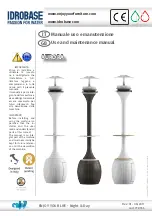
2
DESCRIPTION
Vision 2 is a full facemask that conforms to EN12942 TM3. There are three size versions of the mask:
T7/VISION 2/S (small)
T7VISION 2/M (medium)
T7/VISION 2/ML (medium large)
With an option of standard head harness or PN (Polynet).
The face seal and neckstrap are silicone elastomer and the headharness is EPDM. The coated
polycarbonate visor meets the impact requirements of EN166, Grade B.
The inner mask, with speech diaphragm, reduces carbon dioxide dead space and minimised visor
misting. The maximum weight of the mask without the air hose is approximately 730 grams.
In use, filtered air from the Tornado blower is delivered via an air hose, over the inner surface of the visor
(keeping it clear of misting) and into the inner mask through inlet valves. Exhaled air flows out of the
inner mask through the exhale valve to the atmosphere.
Vision 2 is easily dismantled for repair and servicing, requiring only a pozi-drive screwdriver to undo the
front fitting. Servicing should only be carried out by trained, authorised personnel.
USING T7/VISION 2
1.
Check that the facemask, inhale and exhale valves and head harness are clean and undamaged.
2.
Check that the filter(s) fitted are not clogged or time expired and are suitable for the hazards that
may be encountered. If necessary fit new filter(s). Check that a filter seal(s) is in place and is in
good condition. Replace if necessary.
3.
Check that the exhale valve is clean and in good condition. Check that the valve flap is not
distorted.
4.
Hang the mask around your neck by the neckstrap, fully slacken the head harness and remove the
filter cover. The neckstrap pin can be prressed into the hole at the top of the head harness to
support the facemask in an upright attitude, keeping it free from dust and debris when the mask is
not in use.
5.
Hold the head harness with the thumbs inside the harness. Fit the chin into the chin-cup and then
pull the harness over the head. Gently tighten the harness straps: lower first, then the middle
straps and then the top strap. A good seal should be achieved without over tightening, which will
cause the facemask seal to distort and cause discomfort.
6.
Check the face to mask seal before connecting the blower air hose by blocking the mask inlet and
breathing in. The mask should pull onto the face. Hold your breath for 10 seconds and check that
the mask seal is maintained over the 10 seconds. If the seal fails, indicated by the mask pulling
away from the face, adjust the mask seal to the face, then repeat the test. If it fails a second time
the mask should be serviced.
WARNING If the mask does not seal after servicing, it MUST NOT be used.
7.
Connect the hose to the facemask, check that the elbow is at a suitable angle and tighten the nut.
8.
Arrange the breathing hose so that it trails freely down the back and is not kinked or likely to snag.
9.
See the T/POWER leaflet for further user information.
AFTER USE
1.
DO NOT remove the facemask until well clear of the hazard area.
2.
The mask must be cleaned after use. DO NOT use solvent, detergent or abrasive cleaners that
may damage the mask. After any service procedure the leak test described above must be
performed to ensure that the mask is safe to use.
3.
Replace the filter cover. Check that the filter is not clogged, saturated or time expired. If it is either
clogged, saturated or time expired, renew it.
























